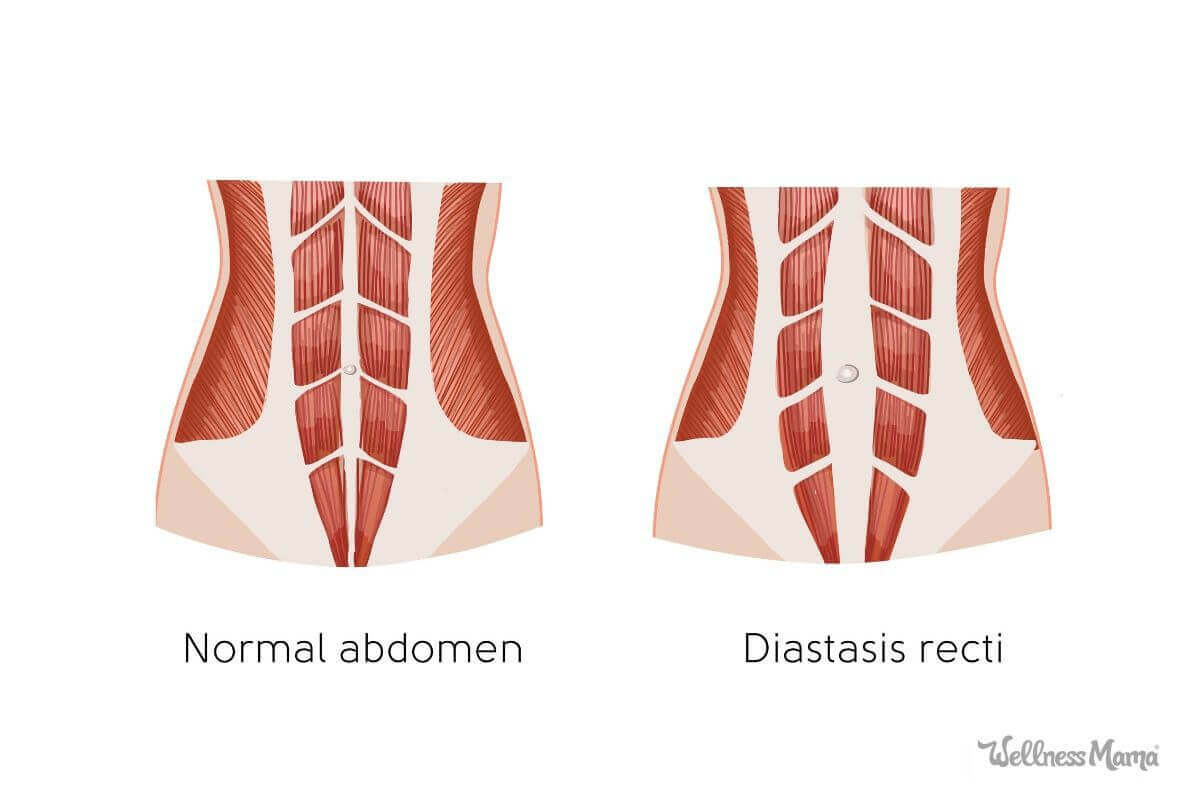

Pregnancy and childbirth can change your body in many ways as your belly grows and hormones fluctuate. These two factors can also contribute to a condition called diastasis recti and change your body even after your new baby arrives.
While all women experience some abdominal muscle separation during pregnancy it is estimated that almost 40% of women have a severe separation known as diastasis recti at 6 months postpartum.
In recent years, diastasis recti has become a more well-known condition. It’s starting to get quite a bit of attention among moms, especially those of us who have had a few kids.
So, what is it and what do we do about it?
What is Diastasis Recti?
Diastasis Recti is separation of the abdominal muscles. It is a gap of 2.7 cm or more between the sides of the rectus abdominis muscle. The rectus abdominis muscles are the pair of muscles that run vertically on each side of the abdomen. In a very fit person, these muscles are highly visible and referred to as a “6 pack”.
During pregnancy the rectus abdominis muscles are stretched by the growing uterus. This condition is more common in women who have had multiple children because of the repeated stretching of the muscles, but it can also appear in women who have had one or two pregnancies.
Other factors that make a women more likely to developing diastasis recti during pregnancy are her age (pregnancy over the age of 35), a large baby, carrying multiple babies, as well as excessive abdominal exercising after the first trimester of pregnancy. (1)
Usually after pregnancy the muscle opening between the rectus abdominis muscles shrinks back over time. When it doesn’t, diastasis recti is the result.
Most women with diastasis recti notice that even after losing their baby weight and getting back into shape they still have a “baby bump” or “pooch”. This is because the abdominal muscles have not gone back together.
How to Figure Out if You Have it?
A gap of 2.7 cm is a bit arbitrary for the average person, so when diagnosing how bad of a separation one has, you use the number of fingers that can be fit into the gap to figure out how large the separation is. Typically, a gap or separation of the muscles is not a problem unless it is greater than 2 fingers.
This type of examination is usually performed after pregnancy. Lay flat on your back and bend your knees with your feet remaining flat on the ground. Then, slightly raise your head so that your chin comes to your chest (like you are just beginning to do a crunch). This will make your abdominal muscles tense. You then place your fingers in the midline area, parallel to your waistline and move them back and forth feeling for the sides of your rectus abdominis muscles. You want to test for the separation at your belly button as well as above and below it.
If there is an opening between the muscles and you are able to fit 2 or more fingers in that area, you have a diastasis recti. This video does a great job of showing exactly how to check for a diastasis:
What Not to Do
It is important not to do crunches, sit ups, or planks until your muscles are healed. Some women (or their trainers) mistakenly think that if a women has separation in her abdominal muscles then doing crunches or sit ups will remedy it. This can make the separation worse by continuing to put strain on the rectus abdominis muscles and building only the outer muscles, rather than building the deep core muscles.
If for some reason you must do these type of exercises before your diastasis is completely healed, support the muscles on the sides of your abdomen with hands or use Kinesio tape to support your abdominal muscles. But really, it’s just best not to even do these exercises until you have healed your diastasis.
How to Fix Diastasis Recti
The first thing to do is to work on finding the transverse abdominal (TVA) muscles, isolating them, and practicing breathing exercises. It sounds simple but this is the basis for all of your diastasis recti healing.
This exercise can be started in the first week after giving birth. It’s very gentle and will go a long way to building the inner core muscles and preparing the body for the other suggested exercises that will help to remedy the condition.
The easiest way to work on this breathing is while lying flat on the back with feet flat on the ground and drawing bellybutton down towards the spine. This video shows how to find and contract TVA muscles:
This video gives a better view of exactly what the muscles should look like as they are contracting.
You should work up to doing this exercise in sets of 10 several times a day before moving on to the next exercise.
The next exercise to work on is the pelvic tilt. This exercise is done by again lying flat on your back and bending your knees while keeping your feet flat on the ground and slightly curling your tailbone up to your bellybutton as you flatten your back. Then you untuck the tailbone bringing it back down and creating a small arch in your back. Pelvic tilts not only work your core muscles but also your pelvic floor muscles, which all new mommas can use. This video demonstrates the correct way to do a pelvic tilt:
Now that you’ve got the TVA contractions and the pelvic tilt down, you can begin to add more exercises into your routine. This video starts with the TVA contractions and pelvic tilts and then adds 4 more exercises including “core stabilization”, “the march”, “the march with stabilization”, and “the reverse march in the 90 zone”. You’ll see how these exercises all build on one another with their basis being the TVA contraction and pelvic tilt:
During this time you can continue to monitor your progress and healing by repeating the diastasis recti test to see if your diastasis is closing and less fingers are fitting in the open space. Remember, this takes time (often months) and won’t happen overnight.
Is there Anything That Can Prevent it During Pregnancy?
While most women don’t realize they have a diastasis until after giving birth, some may want to check it during pregnancy. Early in pregnancy it can be done in the same way previously described for after birth. This article shows how to check for diastasis recti later in pregnancy, after about 20 weeks.
As with after pregnancy, certain exercises are not recommended during pregnancy. These include crunches, frontal planks, exercises with both feet off the ground, twisting movements, and press/push ups.
The TVA contractions and pelvic tilts can be done during pregnancy to help avoid a prenatal diastasis recti or to work on one from a previous pregnancy. They should be modified so that you are not flat on your back. This article gives examples of how to do these standing up against a wall instead of lying down on the floor.
As pregnancy progresses, everyday things become harder to do (as any of us who have been pregnant can attest). Even rolling out of bed can become a challenge in later pregnancy, and it turns out sitting up incorrectly may aggravate diastasis recti. This article explains the correct way for a pregnant woman to lay down and to get out of bed so that she is not straining her abdominal muscles.
Some women may have bad posture before pregnancy and others who once had good posture may begin to notice that as their stomachs get bigger their posture becomes worse. Poor posture can also affect the abdominal muscles. In order to keep the abdominal muscles in line it is important to make sure posture is correct during your everyday activities as well as during exercise.
Along with posture comes the idea of rib thrusting. Some women are “rib thrusters” and this puts added strain on the abdominal muscles and can separate the recti muscles, especially during pregnancy. (Here’s how to tell if you are a rib thruster or not)
When to Seek Professional Help?
When a separation is greater than 3 fingers and is causing other problems such as lower back pain, chronic constipation, urine leakage, or other pelvic floor problems it may be time to find professional help. A physical therapist will be able to help you work on specific exercises to heal your diastasis as well as pelvic floor and make sure you are doing them correctly. Your physical therapist may also suggest wearing a belly splint which holds the abdominal muscles together. It’s great to find a physical therapist who specializes in women’s issues. To find one, go to The American Physical Therapy Association’s website and choose “women’s health”.
Now What?
Before jumping right back into your old exercise routine you may want to work into a pilates type routine to continue working on your deep core muscles. Once your muscles have pulled back together to less than two fingers width apart then you can begin to work on building the outer muscles by doing sit ups and crunches. It may take a good 6-9 months to get to this point, so be patient.
Have you dealt with diastasis recti? How did you heal from it?
How to Identify and Fix Diastasis Recti originally written by Wellness Mama.
from Wellness Mama » Blog http://wellnessmama.com/60398/diastasis-recti/?utm_source=rss&utm_medium=rss&utm_campaign=diastasis-recti
via SEO Derby
No comments:
Post a Comment